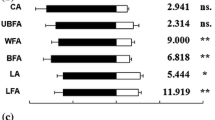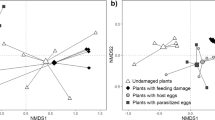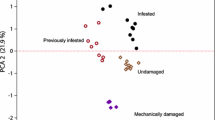Abstract
Diaeretiella rapae (M'Intosh) (Hymenoptera: Aphidiidae) is a parasitoid of several aphid species, including the Russian wheat aphid (RWA),Diuraphis noxia (Mordvilko), and the cabbage aphid (CA).Brevicoryne brassicae (L.). The response of matedD. rapae females to odors from wheat, cabbage, and plant-host complexes was investigated using a four-choice olfactometer. Experienced parasitoids, but not inexperienced females, responded positively to odors of the wheat-RWA complex in a no-choice test. In choice tests, experienced parasitoids did not respond to odors of uninfested cabbage and wheat leaves, but did respond positively to aphid-infested plants and to aphids alone. The response ofD. rapae to the cabbage-CA complex and to CA alone was significantly greater than to the wheat-RWA complex and RWA alone, suggesting an innate odor preference for crucifer-feeding aphids.
Similar content being viewed by others
References
Bouchard, Y., andCloutier, C. 1984. Honeydew as a source of host-searching kairomones for the aphid parasitoidAphidius nigripes (Hymenoptera: Aphidiidae).Can. J. Zool. 62:1513–1520.
Bouchard Y., andCloutier, C. 1985. Role of olfaction in host finding by aphid parasitoidAphidius nigripes (Hymenoptera: Aphidiidae).J. Chem. Ecol. 11:801–808.
Budenberg, W.J. 1990. Honeydew as a contact kairomone for aphid parasitoids.J. Kans. Entomol. Soc. 55:139–148.
Buttery, R.G., Xu, C. andLing, L.C. 1985. Volatile components of wheat leaves (and stems): Possible insect attractants.J. Agric. Food Chem. 33:115–117.
DeJong, R., andKaiser, L. 1991. Odor learning byLeptopilina boulardi, a special parasitoid (Hymenoptera: Eucoilidae).J. Insect. Behav. 4:743–750.
Eller, F.J., Tumlinson, J.H., andLewis, W.J. 1988. Beneficial arthropod behavior mediated by airborne semiochemicals. II. Olfactometric studies of host location by the parasitoidMicroplitis croceipes (Cresson) (Hymenoptera: Braconidae).J. Chem. Ecol. 14:425–434.
Geden, C.J., Smith, L., Long, S.J., andRutz, D.A. 1992. Rapid deterioration of searching behavior, host destruction, and fecundity of the parasitoidMuscidifurax raptor (Hymenoptera, Pteromalidae) in culture.Ann. Entomol. Soc. Am. 85: 179–187.
Grasswitz, T.R., andPaine, T.D. 1992. Kairomonal effect of an aphid cornicle secretion onLysiphlebus testaceipes (Cresson) (Hymenoptera, Aphidiidae).J. Insect Behav. 5:447–457.
Grasswitz, T.R., andPaine, T.D. 1993. Effects of experience on in-flight orientation to host-associated cues in the generalist parasitoidLysiphlebus testaceipes.Entomol. Exp. Appl. 68:219–229.
Guerrieri, E. Pennacchio, F., andTremblay, E. 1993. Flight behaviour of the aphid parasitoidAphidius ervi (Hymenoptera: Braconidae) in response to plant and host volatiles.Eur. J. Entomol. 90:415–421.
Mackauer, M., andStary, P. 1967. Hym. Ichneumonoidea, World Aphidiidae, p. 167,in V. Delucchi and G. Remaudiere (eds.). Index of Entomophagous Insects. Le François, Paris.
McKinnon, L.K., Gilstrap, F.E., Gonzalez, D., Wooley, J.B., Stary, P. andWharton, R.A. 1992. Importations of natural enemies and biological control of Russian wheat aphid, 1988–1991, pp. 136–145,in W.P. Morrison (comp.). Proceedings of the Fifth Russian Wheat Aphid Conference, Fort Worth, Texas. Great Plains Agriculture Council Publication 142.
Nordlund, D.A., Lewis, W.J., andAltieri, M.A. 1988. Influences of plant produced allelochemicals on the host and prey selection behavior of entomophagous insects, pp. 65–90,in P. Barbosa and D.K. Letourneau (eds.). Novel Aspects of Insect-Plant Interaction. John Wiley & Sons, New York.
Powell, W., andZhang, Z.-L. 1983. The reactions of two cereal aphid parasitoids,Aphidius uzbekistanicus andA. ervi to host aphids and their food plants.Physiol. Entomol. 8:439–443.
Read, D.K., Feeney, P.P., andBoot, R.B. 1970. Habitat selection by the aphid parasiteDiaeretiella rapae (Hymenoptera: Braconidae) and hyperparasiteCharips brassicae (Hymenoptera: Cynipidae).Can. Entomol. 102:1567–1578.
SAS Institute. 1985. SAS/STAT User Guide, Release 6.03. SAS Institute, Cary, North Carolina.
Schuster, D.J., andStarks, K.J. 1974. Response ofLysiphlebus testaceipes in an olfactometer to a host and a non-host insect and to plants.Environ. Entomol. 3:1034–1035.
Sheehan, W., andShelton, A.M. 1989a. The role of experience in plant foraging by the aphid parasitoidDiaeretiella rapae (Hymenoptera: Aphidiidae).J. Insect Behav. 2:743–759.
Sheehan, W., andShelton, A.M. 1989b. Parasitoid response to concentration of herbivore food plants: Finding and leaving plants.Ecology 70:993–998.
Steinberg, S., Dicke, M., andVet, L.E.M. 1993. Relative importance of infochemicals from first and second tropic level in long-range host location by the larval parasitoidCotesia glomerata.J. Chem. Ecol. 19:47–59.
Titayavan, M., andAltieri, M.A. 1990. Synonome-mediated interactions between the parasitoidDiaeretiella rapae andBrevicoryne brassicae under field conditions.Entomophaga 14:499–507.
Turlings, T.C.J., andTumlinson, J.H. 1991. Do parasitoids use herbivore-induced plant chemical defenses to locate hosts?Fla. Entomol. 74:42–50.
Turlings, T.C.J., Tumlinson, J.H., Lewis, W.J., andVet, L.E.M. 1989. Beneficial arthropod behavior mediated by airborne semiochemicals. VIII. Learning of host-related odors induced by a brief contact experience with host byproducts inCotesia marginiventris (Cresson), a generalist larval parasitoid.J. Insect. Behav. 2:217–225.
Turlings, T.C.J., Scheepmaker, J.W.A., Vet, L.E.M., Tumlinson, J.H., andLewis, W.J. 1990. How contact foraging experiences affect preferences for host-related odors in the larval parasitoidCotesia marginiventris (Cresson) (Hymenoptera: Braconidae).J. Chem. Ecol. 16:1577–1589.
Vet, L.E.M., andDicke, M. 1992. Ecology of infochemical use by natural enemies in a tritrophic context.Annu. Rev. Entomol. 37:141–172.
Vet, L.E.M., Van Lenteren, J.C., Heymans, M., andMeelis, E. 1983. An airflow olfactometer for measuring olfactory responses of hymenopterous parasitoids and other small insects.Physiol. Entomol. 8:97–106.
Vinson, S.B. 1981. Habitat location, pp. 51–57.in D.A. Nordlund, R.L. Jones, and W.J. Lewis (eds.). Semiochemicals: Their Role in Pest Control. John Wiley & Sons, New York.
Weseloh, R.M. 1981. Host location by parasitoids, pp. 79–95,in D.A. Nordlund, R.L. Jones, and W.J. Lewis (eds.). Semiochemicals: Their Role in Pest Control. John Wiley & Sons, New York.
Wickremasinghe, M.G.V., andvan Emden, H.F. 1992. Reactions of adult female parasitoids, particularlyAphidius rhopalosiphi, to volatile chemical cues from the host plants of their aphid prey.Physiol. Entomol. 17:297–304.
Author information
Authors and Affiliations
Rights and permissions
About this article
Cite this article
Reed, H.C., Tan, S.H., Haapanen, K. et al. Olfactory responses of the parasitoidDiaeretiella rapae (Hymenoptera: Aphidiidae) to odor of plants, aphids, and plant-aphid complexes. J Chem Ecol 21, 407–418 (1995). https://doi.org/10.1007/BF02036738
Received:
Accepted:
Issue Date:
DOI: https://doi.org/10.1007/BF02036738




